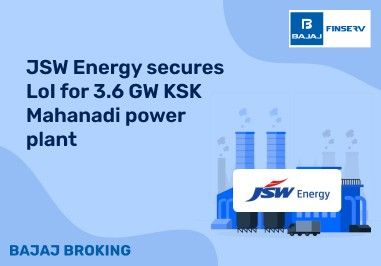What is the meaning of an order book in trading?
- Answer Field
-
An order book is a digital ledger that shows all buy and sell orders for a stock, organized by price levels, helping traders gauge market depth.
BAJAJ BROKING
In this article, we will discuss the meaning and nature of order books and trade books. We will also get into a detailed comparison between the two books. We will further explain why it is important to know their differences.
The order book and trade book are powerful tools for traders. The order book shows all the buying and selling orders placed in the market, while the trade book records the trades executed. An understanding of both allows traders to make better decisions and take lessons from market tendencies. Anyone with an online demat account who is actively trading should have an idea of what these books are about.
An order book shows all the open buy and sell orders for a stock at different price levels. Suppose the last trade price of a stock is INR 100; then, the order book will show the bids below INR 100 and the offers above. The demand and supply numbers are estimated using this information by traders, which helps them in stating the probable price movements.
An order book is a continuously updated, digital list of every buy and sell order for an asset -a stock, in this case - that traders have entered into the stock market. It displays the amount of shares being supplied or demanded at different price levels and helps traders understand the concept of market depth and liquidity, and what may happen to prices. Now that we know what is order book, let’s see how it works.
Additional Read: What is GIFT Nifty?
It includes all buying and selling orders in the market. The order book adopts a price and time priority matching. For instance, if there are two buy orders at the same price, the one placed first will be given priority. When traders analyse the order book, it explains the current mood within the market, and such analysis gives an opportunity to work out demand and supply.
1. Buy Orders (Bids): Lists all buy orders in descending order.
2. Sell Orders (Asks): Items listed here are all sell orders, sorted from the lowest price to the highest.
3. Price Levels: Variety of price levels at which buying and selling orders are placed.
4. Order Size: Quantity of shares requested or offered at each price level.
Trade book contains detailed records of executed trades. Suppose a trader buys 100 shares of a stock at INR150; this trade is dutifully noted in a trade book. It reflects the price with which the trade was executed, the volume of the shares traded, and the timing of trade-all that goes to give a complete view of the trade.
A trade book is a ledger that captures all completed trades in the market. Unlike the order book, reflecting order intentions, the trade book reflects actions executed in the trades. The trade book provides vital information concerning trade volumes, execution prices, and trade times that help traders analyse the activity of a particular market. Now that we know what is trade book, let’s understand how it works.
1. Records Executed Trades: Logs all transactions as they occur.
2. Price and Volume Tracker: It provides the exact price and volume at which the trades were executed.
3. Time Stamps: This shows the exact time each trade was executed.
1. Trade Price - Price at which the trade took place.
2. Volume of Trade: The number of shares traded in each transaction.
3. Trade Time: The exact time the trade occurred.
4. Order ID: Unique identifier for each trade.
Additional Read: What is Trading Account: Definition, Types & Benefits
Now that we have discussed order book and trade book sufficiently, let’s compare the two books and find out how they differ from each other.
Order book vs Trade book:
Order Book | Trade Book | |
Purpose | To show a record of the pending buy and sell orders | To show a record of all the completed trades |
Content | A list of the orders sorted by size and price | A list of completed trades showing their price, volume, and time |
Update | With the placement of a new order, and cancellation of an order, updates are made in real time | Updates are made on completion of a trade |
Insights | Market and depth and liquidity | Market activity and transaction history |
Usage | Analysing potential market movements | Tracking trading performance and details of trade execution |
1. Better Market Analysis: The system provides an understanding of the market sentiment via the order book, supplementary to the trade book.
2. Smart Trading Decisions: Using both books, one can make more tactical entry and exit in the market.
3. Enhanced Risk Management: Helps traders identify and respond to market changes effectively.
The concept of the order book and trade book is imperative to understand in any trade. While the order book presents any trader with the probable movements in the market, the trade book confirms those transactions. Proper use of both could lead to better decisions about trading and a finer analysis of the market.
Disclaimer: Investments in the securities market are subject to market risk, read all related documents carefully before investing.
This content is for educational purposes only. Securities quoted are exemplary and not recommendatory.
For All Disclaimers Click Here: https://bit.ly/3Tcsfuc

Gold Rate Today | 14 January 2025 | Gold Price in India
14 Jan, 2025 | 40 Min. read

HCL Tech expands partnership with Microsoft to transform contact centres
14 Jan, 2025 | 2 Min. read

BEL secures new orders worth Rs 561 crore, boosting FY25 order book
14 Jan, 2025 | 2 Min. read

ITI Ltd secures Rs 64 crore contracts for Wi-Fi and CCTV systems
14 Jan, 2025 | 2 Min. read

JSW Energy secures LoI for 3.6 GW KSK Mahanadi power plant
14 Jan, 2025 | 2 Min. read

Biocon Biologics’ Johor Bahru Facility Receives FDA VAI Classification
13 Jan, 2025 | 2 Min. read

Interarch Secures ₹221 Crore Projects in Semiconductors & Energy Storage
13 Jan, 2025 | 2 Min. read

DMart Appoints Anshul Asawa as CEO Designate, Succeeding Ignatius Noronha
13 Jan, 2025 | 2 Min. read

JSW Energy Completes ₹630 Crore Acquisition of 125 MW RE Assets
13 Jan, 2025 | 2 Min. read

Laxmi Dental IPO- Key Objective & Deep Analysis
13 Jan, 2025 | 4 Min. read

How to Apply for Sat Kartar Shopping IPO & Check Allotment Status?
13 Jan, 2025 | 1 Min. read

How to Apply for Kabra Jewels IPO & Check Allotment Status?
13 Jan, 2025 | 1 Min. read

RBI Launches ULI: Transforming Loan Access
August 27, 2024 | 4 Min. read

Textile Sector in India
September 20, 2024 | 5 Min. read

List of IPOs with DRHPs Filed
November 30, 2023 | 3 Min. read

Aditya Birla Group
September 28, 2023 | 10 Min. read

Bajaj Housing Finance Ltd IPO: Things Smart Investors Need to Know
September 05, 2024 | 4 Min. read

Budget Stock Ideas 2024-2025 | Stocks to Buy Today
July 24, 2024 | 4 Min. read

IPO Eligibility Criteria : Full Details
March 15, 2024 | 6 Min. read

What Is the Lock-In Period in IPOs?
October 18, 2023 | 6 Min. read

Godfrey Phillips Announces 2:1 Bonus Shares
September 16, 2024 | 7 Min. read

Jindal Group- A Comprehensive Analysis
September 27, 2024 | 7 Min. read
An order book is a digital ledger that shows all buy and sell orders for a stock, organized by price levels, helping traders gauge market depth.
A trade book records completed transactions, showing executed prices and volumes, while the order book shows all open buy and sell orders.
The order book helps traders analyse market depth, identify demand and supply levels, and make informed trading decisions.
Traders use the order book to see the number of buy and sell orders at different prices, helping them gauge market sentiment and potential price movements.
Yes, the order book can change quickly as new orders are placed, modified, or canceled, reflecting real-time market conditions.
The trade book shows details of completed trades, including the execution price, volume, and time of each trade.
Comparing both books helps traders understand market sentiment (order book) and validate it with actual trading activity (trade book).
No Result Found
Level up your stock market experience: Download the Bajaj Broking App for effortless investing and trading
